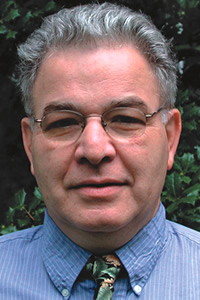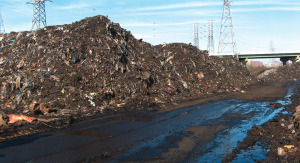
Neil Seldman
BioCycle January 2015
The recent closing of the Wilmington Organics Recycling Center (WORC) in Delaware, due to the loss of its operating permit, has pushed the need for a distributed and diverse composting infrastructure to the fore. The facility’s closure in October 2014 left source separated food scraps programs from New York City to Washington, D.C., scrambling to find alternative sites to tip their loads. Developed by The Peninsula Compost Group (TPCG), the facility — located near the Port of Wilmington off of Interstate 95 — was designed to receive 600 tons/day of source separated organic materials from government institutions, grocery chains, schools, food processors, sports venues, restaurants, and other large food waste generators. It also serviced a handful of residential food waste collection programs.
A separate entity, Peninsula Compost Company (PCC), was set up to finance and own the plant. Its original members included the EDiS Company and Greenhull Compost LLC (both of Wilmington, Delaware), as well as the developers, TPCG. The facility commenced operations in late 2009, composting around 200 tons/day. For the first two years, TPCG was the managing and operations partner. During that time there were no verified odor complaints or Notices of Violation from the State of Delaware and the compost produced met every federal and state standard for unrestricted use.
However, the anticipated ramp-up to 600 tons/day of incoming food waste did not occur as anticipated, placing economic strains on the facility. In 2011, Waste Management Inc. (WMI) approached PCC, seeking to participate as an investor in the project and to provide food and wood waste to fill the facility’s capacity. This overture and ensuing transaction were welcomed given WMI’s interest in accelerating organics recycling services and developing value-added compost-based products in the Mid-Atlantic. WMI invested millions into buying the largest individual ownership share of PCC. When WMI announced this strategic investment in PCC in May 2011, it touted the facility’s ability to add over 200,000 tons to the company’s total organics processing capacity at the time. Despite incentives to increase the volume of organics processed, WMI was unable to help PCC reach the plant’s 600 tons/day capacity and the material delivered by all haulers was too often contaminated.

Material delivered to the Wilmington Organics Recycling Center in Delaware, which closed in October 2014, was too often contaminated, as seen in this photo of a windrow at the facility. File Photo, DE Dept. of Natural Resources and Environmental Control
Material delivered to the Wilmington Organics Recycling Center in Delaware, which closed in October 2014, was too often contaminated, as seen in this photo of a windrow at the facility.[/caption]In mid-February 2012 — within a year of WMI’s investment — TPCG was removed as the operations manager and eliminated as voting members, a step that made WMI the majority voting member of PCC, with the largest controlling interest. However, WMI maintains it never could and still cannot control PCC. This is counterintuitive given that all of the Wilmington plant management people were direct employees of PCC, a company that WMI dominated with a majority of the voting shares.
Between mid 2012 and its closure in fall 2014, the facility received hundreds of odor complaints, Notices of Violation from the State of Delaware, and complaints about plastic and glass contamination in the compost. Although W.L. Gore and Associates, the technology provider, and a number of well-known independent composting consultants and experts made recommendations that would have resolved those issues, most of those suggestions were apparently not acted upon. As a result, the operations continued to suffer from contamination and odor problems. Odors reached area neighborhoods and businesses, even though sufficient buffer areas existed.
On October 20, 2014, the Delaware Department of Natural Resources and Environmental Control, in the face of permit violations, refused to renew the facility’s permit, thus shutting down operations (closure order, press release) All active composting of existing material onsite must to be completed by January 16, 2015. By March 31, 2015, all compost and related waste must be removed. The facility’s closure has not only crippled business and local government food waste diversion programs, but has also given commercial food waste composting a bad name.
Andrew DiSabatino, Jr., Managing Partner of PCC, reported that the Wilmington Peninsula plant would not be reopened. Another plant that had been planned by TPCG for the southern part of Prince George’s County, Maryland, is unlikely to move forward.
Closure of WORC raises questions as to what really led to the facility’s demise. One industry consultant wondered if WMI’s goal was to shut down the plant in order to eliminate competition with its regional landfills. Yet, why wouldn’t WMI want to clean up WORC — a facility they partly owned with the largest controlling interest — in order to secure ongoing capacity for the growing food waste composting sector? Consider that the lack of wood waste to balance the highly nitrogenous food waste was one of the most critical problems facing WORC. WMI could have delivered adequate carbon materials for composting but did not; its Tullytown, Pennsylvania landfill (~55 miles from Wilmington) receives tens of thousands of tons of yard and wood waste, for which it earns landfill tip fees.
According to WMI spokesperson, John Hambrose, WMI remains committed to organics recycling and is involved in numerous other projects and operations across the U.S and Canada. WMI, for example, is a partner in Harvest Power’s wet anaerobic digester project in London, Ontario. That facility accepts 67,000 metric tons of material a year and generates 285 megawatts of electricity and other products. Hambrose points out that WMI has made significant investments to increase its capacity to manage organic material. “Our customers want this service so we invest in facilities that will help us meet the demand for composting services,” he explained. “WMI invests to succeed.” The company operates 39 yard trimming and food waste facilities in the U.S. Referring to the growing “zero waste to landfill” movement, Hambrose stated, “We need composting capacity to build our business.” Indeed, WMI used the Wilmington facility to successfully win the bid to transfer New York City’s source separated organics.
Distributed Composting
Is there too much reliance on distant far-away facilities? The Institute for Local Self-Reliance’s (ILSR) Composting Makes $en$e Director, Brenda Platt, who has been trained as a composting facility operator in Maryland, thinks so. “There is not enough focus on home composting and small-scale farm and community sites, followed by onsite institutional systems and then development of medium sized private and public operations for remaining organics,” she asserted. “One beauty of composting is that it can be small-scale, large-scale, and everything in between. We need more emphasis on locally based systems as the priority.”
No matter what scale the facility, proper management and quality control are essential. As noted by Nora Goldstein, Editor of BioCycle, “What is key in compost manufacturing at any scale is production of a high quality compost as that opens doors to a wide range of markets and end uses — from growing food to managing storm water and erosion. This requires clean incoming feedstock.”
Indeed, cities could be developing closed loop local systems to recycle food waste into compost to green neighborhoods and enhance the health of urban soils. Compost is increasingly valued for its ability to improve water retention in soil, treat nonpoint source pollution, and cut sedimentation run-off via green infrastructure such as rain gardens and bioswales. Centralized, far-away facilities make it harder to return finished compost back to the community for use.
The good news is that there is huge potential to expand composting at the local level. ILSR’s 2014 report, Growing Local Fertility: A Guide to Community Composting, describes successful initiatives in 14 states and the District of Columbia. Programs range from urban to rural and include demonstration/training sites, schools, universities, pedal-powered collection systems, worker-owned cooperatives, community gardens, and farms employing multiple composting techniques. At recent forums in Baltimore (sponsored by BioCycle and ILSR) and Philadelphia (sponsored by the City Council), community-scale composters spoke before enthusiastic audiences.
If implemented, a decentralized approach — one that combines home and community-scale composting with on-farm and medium-sized operations — would create jobs, reduce private and public sector costs for managing waste, and better tie compost to healthy soils and local food production, thereby reinforcing a community culture of sustainability and engaged environmental stewardship. Moreover, with a diverse infrastructure, problems at one site will not disrupt the whole system.
For further information on the benefits of composting, composting basics, national and state statistics, model programs, policy opportunities, and a discussion of community-scale composting, see ILSR’s 2014 report State of Composting in the US: What, Why, Where & How. To learn more about ILSR’s Neighborhood Soil Rebuilders composter-training project (a collaborative project with ECO City Farms), email NeighborhoodSoilRebuilders@gmail.com.
Neil Seldman is president of the Institute for Local Self-Reliance (www.ilsr.org). This article was produced under ILSR’s Composting Makes $en$e Project.









